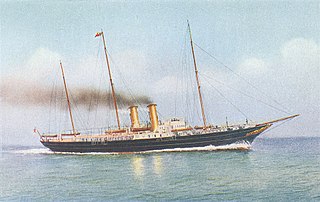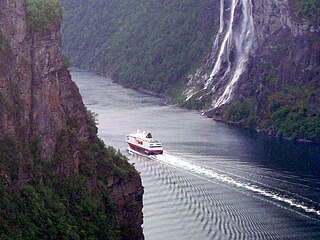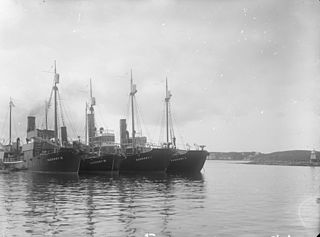Hurtigruten, formally Kystruten Bergen-Kirkenes, is a Norwegian public coastal route transporting passengers that travel locally, regionally and between the ports of call, and also cargo between ports north of Tromsø.

The Norwegian campaign involved the attempt by Allied forces to defend northern Norway coupled with the resistance of the Norwegian military to the country's invasion by Nazi Germany in World War II.

Operation Sportpalast, also known as Operation Nordmeer, was a German naval raid between 6 and 13 March 1942 against two of the Allied Arctic convoys of World War II as they passed through the Norwegian Sea. It was conducted by the battleship Tirpitz, three destroyers and eight submarines. The German ships were unable to locate either of the convoys but sank a merchant vessel that was sailing independently. The Allies attempted to intercept the German force, also without success.

HMY Alexandra was a steamship built as a British royal yacht, completed in 1908. Normally transporting Britain's royal family to European ports, Alexandra served as a hospital ship during the First World War. After 17 years of British service, she was sold to Norwegian commercial interests in 1925. Renamed Prins Olav, she was first used as a luxury cruise ship on trips to the North Cape, she was converted to take more passengers and cargo. In 1937 she began sailing as a Hurtigruten passenger/cargo ship along the coast of Norway. After being requisitioned by the Norwegian government following the 9 April 1940 German invasion of Norway, she transported troops for the Norwegian war effort. Prins Olav was sunk by German bombers on 9 June 1940, while attempting to escape to the United Kingdom as the Norwegian Campaign was coming to an end.

HNoMS Kjell was the final ship of twenty-seven 2nd class torpedo boats built for the Royal Norwegian Navy, launched at the Royal Norwegian Navy's shipyard in Horten on 12 March 1912 with build number 106. Kjell saw more than 32 years of service, the first 28 years in the Royal Norwegian Navy during the First World War and in the interwar period, the last four in the Kriegsmarine, having been captured in the first days of the 1940 Norwegian campaign. After being rebuilt as a minesweeper by the Germans, she was sunk by Royal Air Force de Havilland Mosquito fighter bombers on 28 September 1944. Divers rediscovered the shipwreck in 2006.

Hurtigruten AS is a Norwegian coastal ferry service and cruise line headquartered in Oslo, Norway. It is one of two companies currently operating Hurtigruten, the coastal ferry service along the Norwegian coast from which it takes its name.

Trondhjems mekaniske Værksted or TMV was a major shipbuilding company in Trondheim, Norway.

Río Chira was 199-ton steel-hulled vessel with a long and varied history, serving under several names as a whaler, fishing boat, naval patrol boat, passenger/cargo ship and freighter between 1914 and 1981.

HNoMS Honningsvåg was a naval trawler that served throughout the Second World War as a patrol boat in the Royal Norwegian Navy. She was launched at the North Sea harbour of Wesermünde in Hanover, Germany in February 1940 as the fishing trawler Malangen and was captured by Norwegian militiamen at the North Norwegian port of Honningsvåg during her maiden fishing journey to the Barents Sea. Having taken part in the defence of Norway in 1940 she spent the rest of the war years patrolling the ocean off Iceland. She was decommissioned in 1946, sold to a civilian fishing company in 1947 and scrapped in 1973.

SS Sanct Svithun was a 1,376 ton steel-hulled steamship built by the German shipyard Danziger Werft and delivered to the Norwegian Stavanger-based shipping company Det Stavangerske Dampskibsselskab on 1 July 1927. She sailed the Hurtigruten route along the coast of Norway until she was lost in an air attack on 30 September 1943 during the Second World War.

SS Irma was a 1,322-ton steamship built by the British shipyard Sir Raylton Dixon & Co. Ltd. in Middlesbrough in the north-east of England. She was delivered to the Norwegian passenger ship company Det Bergenske Dampskibsselskab of Bergen in 1905. Irma sailed for the company until she was attacked and sunk by two MTBs belonging to the Royal Norwegian Navy on 13 February 1944.

SS Dronning Maud was a 1,489 ton steel-hulled steamship built in 1925 by the Norwegian shipyard Fredrikstad Mekaniske Verksted in Fredrikstad. Dronning Maud was ordered by the Trondheim-based company Det Nordenfjeldske Dampskipsselskap for the passenger and freight service Hurtigruten along the coast of Norway. She served this route as the company flagship until she was sunk under controversial circumstances during the 1940 Norwegian Campaign.

Richard Bernhard With was a Norwegian ship captain, businessman, and politician for the Liberal Left Party. He is known as the founder of the shipping companies Vesteraalens Dampskibsselskab and Hurtigruten.

The Bergen Steamship Company (BDS), was founded in 1851 by Michael Krohn to operate a shipping service between the Norwegian ports of Bergen, Stavanger, and Kristiansand and the German port of Hamburg with the paddle steamer Bergen. The company funnel was black with three widely spaced narrow white bands.
Sophus Weidemann was a Norwegian engineer and industrialist who contributed to the development of the shipping industry in Norway.

Z16 Friedrich Eckoldt was a Type 1934A-class destroyer built for Nazi Germany's Kriegsmarine in the late 1930s. It was named after Kapitänleutnant Friedrich Eckoldt (1887–1916), the commander of torpedo boat V 48, who was killed when his boat was sunk during the Battle of Jutland on 31 May 1916.
Two steamships have borne the name Barøy, after the Norwegian island Barøy:

SS Nordnorge was a Norwegian steamship built in 1923–24 by Trondhjems mekaniske Værksted, for the Narvik-based Norwegian shipping company Ofotens Dampskibsselskap. First employed on the company's Narvik-Trondheim route, she was transferred to the longer Hurtigruten route in late 1936. Seized by the Germans following their April 1940 attack on Norway, she was used as covert troop ship and was sunk shortly after delivering her cargo of German troops behind Allied lines on 10 May 1940.
Two steamships have borne the name Nordnorge, after the Norwegian name for Northern Norway:

SS Sirius was a Norwegian iron-hulled steamship built in Germany in 1885. Sirius spent over 55 years sailing with cargo, regular passengers and tourists between Norway and Europe, and on the Norwegian coast. In 1894-1895, she served a year on the Hurtigruten route on the coast of Norway, before reverting to her former duties.

















